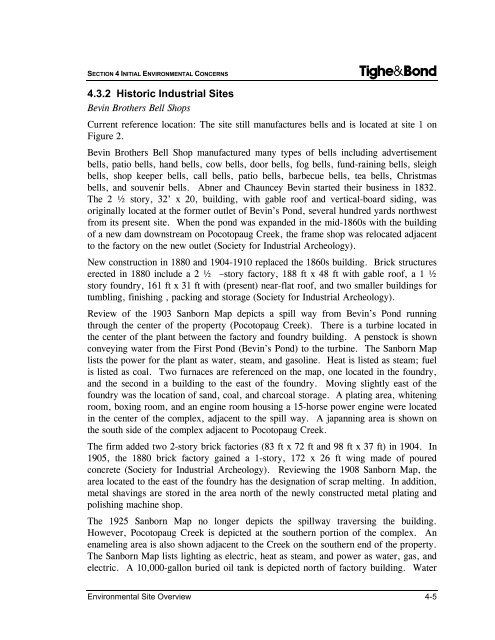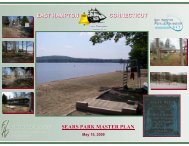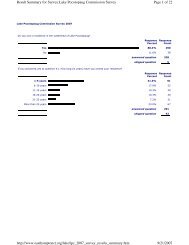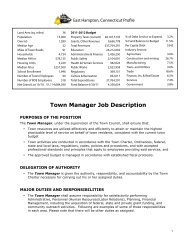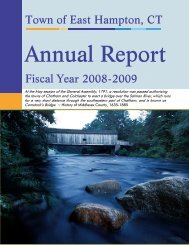Environmental Site Overview - East Hampton, Connecticut
Environmental Site Overview - East Hampton, Connecticut
Environmental Site Overview - East Hampton, Connecticut
Create successful ePaper yourself
Turn your PDF publications into a flip-book with our unique Google optimized e-Paper software.
SECTION 4 INITIAL ENVIRONMENTAL CONCERNS<br />
Tighe&Bond<br />
4.3.2 Historic Industrial <strong>Site</strong>s<br />
Bevin Brothers Bell Shops<br />
Current reference location: The site still manufactures bells and is located at site 1 on<br />
Figure 2.<br />
Bevin Brothers Bell Shop manufactured many types of bells including advertisement<br />
bells, patio bells, hand bells, cow bells, door bells, fog bells, fund-raining bells, sleigh<br />
bells, shop keeper bells, call bells, patio bells, barbecue bells, tea bells, Christmas<br />
bells, and souvenir bells. Abner and Chauncey Bevin started their business in 1832.<br />
The 2 ½ story, 32’ x 20, building, with gable roof and vertical-board siding, was<br />
originally located at the former outlet of Bevin’s Pond, several hundred yards northwest<br />
from its present site. When the pond was expanded in the mid-1860s with the building<br />
of a new dam downstream on Pocotopaug Creek, the frame shop was relocated adjacent<br />
to the factory on the new outlet (Society for Industrial Archeology).<br />
New construction in 1880 and 1904-1910 replaced the 1860s building. Brick structures<br />
erected in 1880 include a 2 ½ –story factory, 188 ft x 48 ft with gable roof, a 1 ½<br />
story foundry, 161 ft x 31 ft with (present) near-flat roof, and two smaller buildings for<br />
tumbling, finishing , packing and storage (Society for Industrial Archeology).<br />
Review of the 1903 Sanborn Map depicts a spill way from Bevin’s Pond running<br />
through the center of the property (Pocotopaug Creek). There is a turbine located in<br />
the center of the plant between the factory and foundry building. A penstock is shown<br />
conveying water from the First Pond (Bevin’s Pond) to the turbine. The Sanborn Map<br />
lists the power for the plant as water, steam, and gasoline. Heat is listed as steam; fuel<br />
is listed as coal. Two furnaces are referenced on the map, one located in the foundry,<br />
and the second in a building to the east of the foundry. Moving slightly east of the<br />
foundry was the location of sand, coal, and charcoal storage. A plating area, whitening<br />
room, boxing room, and an engine room housing a 15-horse power engine were located<br />
in the center of the complex, adjacent to the spill way. A japanning area is shown on<br />
the south side of the complex adjacent to Pocotopaug Creek.<br />
The firm added two 2-story brick factories (83 ft x 72 ft and 98 ft x 37 ft) in 1904. In<br />
1905, the 1880 brick factory gained a 1-story, 172 x 26 ft wing made of poured<br />
concrete (Society for Industrial Archeology). Reviewing the 1908 Sanborn Map, the<br />
area located to the east of the foundry has the designation of scrap melting. In addition,<br />
metal shavings are stored in the area north of the newly constructed metal plating and<br />
polishing machine shop.<br />
The 1925 Sanborn Map no longer depicts the spillway traversing the building.<br />
However, Pocotopaug Creek is depicted at the southern portion of the complex. An<br />
enameling area is also shown adjacent to the Creek on the southern end of the property.<br />
The Sanborn Map lists lighting as electric, heat as steam, and power as water, gas, and<br />
electric. A 10,000-gallon buried oil tank is depicted north of factory building. Water<br />
<strong>Environmental</strong> <strong>Site</strong> <strong>Overview</strong> 4-5


